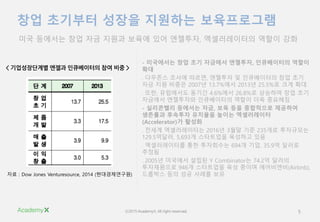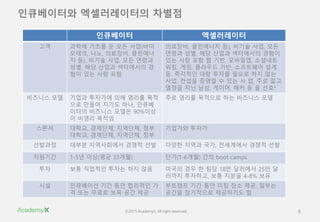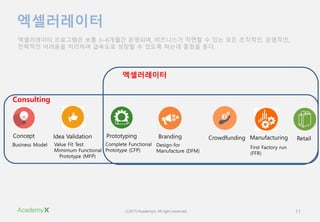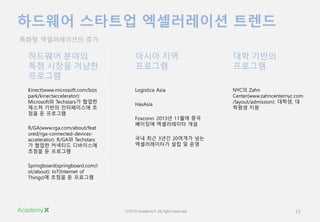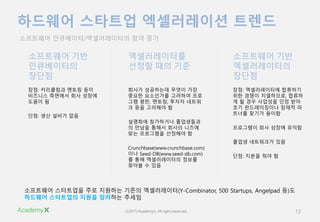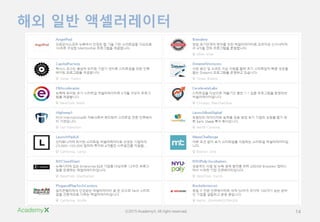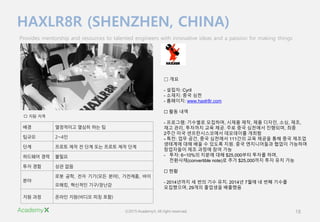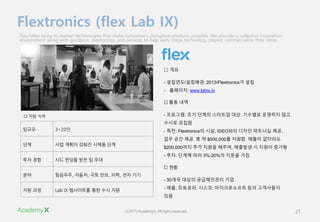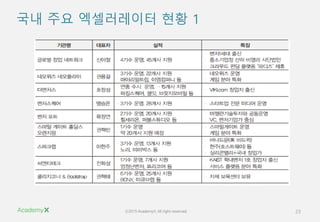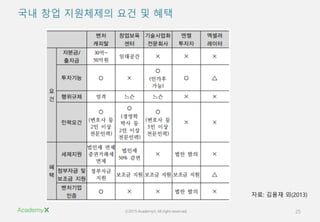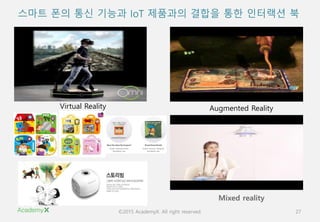5?. ??????? ????? ??
- 1. ???? ????? ?? ???. ???? ??????? ????? ??
- 2. ?2015 AcademyX. All right reserved. 2 ???? ?? ?? ?? Startups: How to get funding? * ????? ???? 20?? ?? ??? ?? ?? ?? ?? / ?? ?? / ? ??? ?? / ???? ?? / ??-?? ?? / ??? ?? / ??? ?????? / ??? ?? / ?? ?? ?? / ???? ?? ?? / ??? ?? / ????? ? ? ????? ?? / ??? Pivot / ??? ?? ?? ??? ?? ??? ??? ?? / ?? ?? / ?? ??? ??? / ??? ?? / ???? ??? / ??? ??/ ??? Pivot ??
- 3. ?2015 AcademyX. All right reserved. 3 ??? ?? ?? ?? ??? ?? ?? ??? ?? ??? ????? ???? ??, ??? ??? ?? ?? ??? ????? ?? ?? ?? ??/?? ??(Pre-seed stage) ? ??? ??? ?? ??? ?? ?? ??? ?? ??? ?? ???? ???? ??? ????? ?? - ?? ??? ???? ??: OECD ??? ???, ??? ?? ??? ???? 63%? ?? 26%, ?? ?? 13% ?? ?? ????? ??? - ??? ?? ?? ??? ???? ????? ??? ?? ????? ?? * ??? ????? ?? ?? ??? ?? ?? ?? ?? ?? ??? ???? ???? ?? ???? ?? ??? ?? < ?? ??? ?? > ?? : OECD, Entreprenuership at a glance 2014. (???? ???) How To Start A Startup
- 4. ?2015 AcademyX. All right reserved. 4 ???(childhood)? ?????, ???(adolescence) ?????? Business Life Cycle ????? ????? ??? ?? ?? ????, ????? ???? ?? ?? ??? ????. ??? ??? ? ? ?? ????? ??? ? ??? ?????. ??? ?????? ????? ?? 3~6??? ????, ????? ??? ? ?? ?? ????, ????, ???? ???? ???? ???? ??? ? ??? ??? ??? ??. ??? ????? ??? ???? ???? ???? ?? ???? ???? ?? ????? ??? ?? ??. ?????? ??? ????, ?? ??? ?????, ??????? ?? ??? ?????.
- 5. ?2015 AcademyX. All right reserved. 5 ?? ???? ??? ???? ?????? ?? ???? ?? ?? ??? ??? ?? ????, ??????? ??? ?? - ????? ?? ?? ???? ????, ?????? ??? ?? ????? ??? ???, ???? ? ?????? ?? ?? ?? ?? ??? 2007? 13.7%?? 2013? 25.5%? ?? ?? ???, ????? ??? 4.6%?? 26.8%? ???? ?? ?? ???? ????? ?????? ??? ?? ???? - ????? ???? ??, ?? ?? ????? ???? ???? ???? ???? ??? ?????? (Accelerator)? ??? ???? ??????? 2016? 3?? ?? 235?? ????? 129.5???, 5,693? ????? ???? ?? ???????? ?? ????? 694? ??, 35.9? ??? ??? ?2005? ???? ??? Y Combinator? 74.2? ??? ?????? 946? ????? ?? ??? ?????(Airbnb), ???? ?? ?? ??? ?? < ??????? ??? ?????? ?? ?? > ?? : Dow Jones Venturesource, 2014 (???????)
- 6. ?2015 AcademyX. All right reserved. 6 ?????(Incubator)? ??????(Accelerator) - ???? ??????, ?? Business Skill? ?????, ?? ??? ?????, ???? ???? ????? ??????. - ??? ???? ??? ?? ?? ? ??? ?? ? ?? ??? ?? ????? ? ?? ???. - ??? ???? ??'? ??? ? ?????(Incubator) - ??, ??, ?? ?? ?????? ????? ??? ?? ?? ??? ?? - ????? ??? ?? ? ??? ??? ??? ???? ?? - ??(Class) ??? ????, ????(Demo Day)? ???? ????? ?? - ?????? ???? ?? ??????(Accelerator)
- 7. ?2015 AcademyX. All right reserved. 7 ?????(Incubator) ????? ????? ??? ?? ?? ????, ????? ???? ?? ?? ??? ????. ??? ??? ? ? ?? ????? ??? ? ??? ?????. * ??? ??: ?? ????? ??? ??? ??? ??? ??? ?? ???
- 8. ?2015 AcademyX. All right reserved. 8 ?????? ??????? ??? ????? ?????? ?? ??? ??? ? ?? ??(?? ???, ??, ????, ???? ? ?), ??? ??, ?? ??? ??, ?? ??? ????? ? ?? ?? ?? ?? ????, ????? ?), ??? ??, ?? ??? ??, ?? ??? ????? ??? ?? ?? ?? ? ??, ????, ???? ??, ??, ???? ??, ????? ?? ?. ???? ?? ??? ??? ?? ?? ??, ??? ??? ? ?? ? ?, ?? ?? ??? ?? ??, ???, ?? ? ? ??* ???? ?? ??? ???? ?? ??? ?? ?? ??? ??? ??, ??? ??? ???? ??? 90%?? ? ??? ??? ?? ??? ???? ?? ???? ?? ??? ???, ????, ????, ?? ???, ????, ????, ?? ???? ??? ???? ??? ?????? ??? ?? ??? ??? ??, ????? ??? ?? ???? 1-5? ??(?? 33??) ??(1-6??) ?? boot camps ?? ?? ???? ??? ?? ?? ??? ?? ? ?? 18? ???? 25? ? ??? ????, ?? ??? 4-8% ?? ?? ????? ?? ?? ???? ? ? ?? ??? ?? ?? ?? ???? ?? ?? ?? ?? ??, ??? ??? ????? ????? ?
- 9. ?2015 AcademyX. All right reserved. 9 ??????(Acceleration) ?? ???? ? ?? ????? ?? ???? ? ??? ???? ???? ??????? ?? ????? ??? ?? ?? ?? ?? ?? ????, ???, ??? ?? ?? ?? ?? ????? ?? ??? ???? ??? ??? ?? ? ??? ???? ?? < ?? ????? ????? ??? ??> ? ??? ?? ????? ?? ?? ? ?? ???? ??? ?? ????? ?? ? ??? ???? ?? ?? ? ????? ??? ????? ??? ?? : OECD, EY G20 Entrepreneurship Barometer 2013 ? ??? ???? ????. (???????)
- 10. ?2015 AcademyX. All right reserved. 10 - ?? ?????? ?????? ?? ????? ????? ???? ? ? ??? ???? ????? ???? ???? ??, ???, ?? ??, ?? ?? ????? ??? ?? - ???? ????? ???? ???????? ?? ????? ??? ???? ????? ??, ??? ???, ????? ??? ?? ??? ????, ??? ????? ??? ? Hardware Startup Accelerator ??? ??? ??? ?? ??? ???? ??????(Y-Combinator, 500 Startups ?)? ??, ?? ? ?, ??, ??? ??? ???? ??????(Rock Health, TechStars ?)? ?? ???? ?? ????? ??????
- 11. ?2015 AcademyX. All right reserved. 11 ?????? Concept Idea Validation Prototyping Branding Crowdfunding Manufacturing Retail Business Model Value Fit Test Mimimum Functional Prototype (MFP) Complete Functional Prototype (CFP) Design-for Manufacture (DFM) First Factory run (FFR) ?????? Consulting ?????? ????? ?? 3~6??? ????, ????? ??? ? ?? ?? ????, ????, ???? ???? ???? ???? ??? ? ??? ??? ??? ??.
- 12. ?2015 AcademyX. All right reserved. 12 ???? ???? ?????? ??? ??? ??????? ??. Kinect(www.microsoft.com/bizs park/kinectaccelerator): Microsoft? Techstars? ??? ??? ??? ?????? ? ?? ? ???? R/GA(www.rga.com/about/feat ured/rga-connected-devices- accelerator): R/GA? Techstars ? ??? ???? ????? ??? ? ???? Springboard(springboard.com/i ot/about): IoT(Internet of Things)? ??? ? ???? ???? ??? ?? ??? ??? ???? Logistica Asia HaxAsia Foxconn: 2013? 11?? ?? ???? ?????? ?? ?? ?? 3?? 20??? ?? ??????? ?? ? ?? ??? ?? ???? NYC? Zahn Center(www.zahncenternyc.com /layout/admission): ???, ? ??? ?? ?? ??? ????
- 13. ?2015 AcademyX. All right reserved. 13 ???? ???? ?????? ??? ????? ?????/??????? ?? ?? ??: ????? ??? ?? ???? ???? ?? ??? ??? ? ??: ?? ??? ?? ????? ?? ?????? ??? ??? ????? ??? ?? ??? ????? ???? ?? ?? ??, ???, ??? ??? ? ?? ???? ? ???? ????? ????? ? ??? ??? ??? ??? ?? ????? ???? ? Crunchbase(www.crunchbase.com) ?? Seed-DB(www.seed-db.com) ? ?? ??????? ??? ??? ? ?? ??????? ??? ?? ?? ??: ??????? ???? ?? ??? ?????, ??? ? ? ?? ???? ?? ?? ?? ??????? ??? ? ??? ??? ??? ????? ?? ??? ??? ??? ????? ?? ??: ??? ?? ? ????? ?? ??????? ??? ????? ????? ?? ???? ??? ??????(Y-Combinator, 500 Startups, Angelpad ?)? ???? ????? ??? ???? ???
- 14. ?2015 AcademyX. All right reserved. 14 ?? ?? ??????
- 15. ?2015 AcademyX. All right reserved. 15 ?? ?? ??????
- 16. ?2015 AcademyX. All right reserved. 16 LEMNOS LABS (SAN FRANCISCO, CA) Provides mentorship and resources to talented engineers with innovative ideas and a passion for making things ?? ?? ?? ??? 2? ?? ?? ???? ??? ? ???? ?? ??, ??? ?? ? ?? ?? ?? $500k ?? ?? ?? ??, ?? ??(?? ??), ????, ????, ?? ?? ?? ??? ??(? ??, ?? ??, ?? ??, ???? ? ?, ??? ??/?? ?? ??) Ī§ ?? - ????/???: 2011/Jeremy Conrad, Helen Zelman - ???: ?? ?????? - ????: lemnoslabs.com ? ?? ?? - ????: ??(Class)?? ???? ??, ???? ??? ?? ?? ??? ??? - ??: ?? ??, ?? ??? A? ??? ??? ??? ??? ????? ? - ??: ???? ?????? ???? ???? ?? ??, ??? ??, ?? ?? ?? ?? ???? ??? ??, ??, ??, ???, ??? ??? ????? ??? ???? ???. ??, ?? ??? ????? ??? ?? ? ??? ??, ????, ????, ?? ???? ??? ? - ??: ? ??? ?? $200k?? ????, ????? 10% ??? ?? $100K? ??? ? ?? - 2014??? ? 20? ??? ????? ??? ?? ? ?? ??
- 17. ?2015 AcademyX. All right reserved. 17 BOLT (BOSTON, MA) A six-month intensive program designed to help hardware startups grow ?? 6~12?? ??? ?? ??? ??? ?? ??? ? ??? 2~8? ?? 6~12?? ??? ?? ??? ??? ? ??. ??? ??, ?????/??? ??, ?? ?? ?? ???? ?? ??? ?? ?? ?????? ?????? ??? ?? ???? ?? ?? ???? ????, ???? ? ??? ??? ??? ? ?? ?? ?? ?? ?? ??? ??(??? ?? ??) Ī§ ?? - ???: Ben Einstein - ???: ?? ??? - ????: www.bolt.io - ????: ?? ??(seed fund: ?? ??? ????? ??? ???? ??)??, ??????? ???? ?? ????? ??, ??, ??, ??? ?? ???. ???? Ī«toolkit for hardware stratups'?? ? ? ?? ?? - ????: ?? ? ??? ????? ???? ?? ? 6??? ?? ?? - ??: ?? ???? ?? ?? ??/??? ?? ??, ??? ?? ??, ???? ??? ???? VC?? ???? ??. ??? ?? ??? ? ??? ??? ??? ???? 24?? ??? ???. ????, ??????, ??? ?? ??? ?? ?? ??? ??? ? ??? ??? - ???: ????(www.kickstarter.com)? ???? ???? Dragon Innovation(www.dragoninnovation.com)? ???? ??? ????? ??? ?? - ??: ? $50,000 ~ $150,000??? ???? ???? 5~15%?? ?? ??? ??? ?? ??? ? ?? ??
- 18. ?2015 AcademyX. All right reserved. 18 HAXLR8R (SHENZHEN, CHINA) Provides mentorship and resources to talented engineers with innovative ideas and a passion for making things ?? ????? ??? ?? ? ??? 2~4? ?? ??? ?? ? ?? ?? ??? ?? ?? ???? ?? ??? ?? ?? ?? ?? ?? ?? ??, ?? ??(?? ??), ????, ?? ???, ???? ??/??? ?? ?? ??? ??(??? ?? ??) Ī§ ?? - ???: Cyril - ???: ?? ?? - ????: www.haxlr8r.com ? ?? ?? - ????: ???? ????, ??? ??, ?? ???, ??, ??, ?? ??, ???? ?? ??. ?? ?? ???? ????, ?? 2?? ?? ???????? ????? ??? - ??: ?? ??, ?? ???? 111?? ?? ??? ?? ?? ??? ???? ?? ?? ? ??? ??. ?? ?????? ??? ???? ????? ?? ??? ?? ?? - ??: 6~10%? ??? ?? $25,000?? ??? ??, ????(convertible note)? ?? $25,000?? ?? ?? ?? ? ?? - 2014??? ? ?? ?? ??. 2014? 7?? ? ?? ??? ?????, 29?? ???? ???? ? ?? ??
- 19. ?2015 AcademyX. All right reserved. 19 ALPHALAB GEAR (PITTSBURGH, PA) A hardware and robotics startup accelerator that provides physical product companies with investment, mentorship and connections. ?? ?? ?? ?? ??? 2? ?? ?? ?? ?? ???? ?? ??? ?? ?? ?? ?? ?? ?? ??, ??? ??, ?? ??, ??, ?? ? ?, ???, ???? ?? ??? ?? ?? ?? ?? ??? ??? ?? Ī§ ?? - ????: AlphaLab(alphalab.org)?? ??? ???? ??? ????? - ???: ?? ???? - ????: alphalab.org/gear ? ?? ?? - ????: Innovation Works(???? ??? ?? ?? ???), Startbot(?? ?? ???? ??? ?? ??)? ???? ?????, 8?? ?? - ??: ?? ???? ???? ? - ??: AlphaLab Gear ???? ?? ? ???, ????? TechShop ???? ??. ??, ??, ?????, ?? ??? ?? ??? ?? ??? ?? - ??: 5~9% ??? ?? $25,000~$50,000? ??? * ?????? ???? ??? ???? ????? - ?? ???? ?? - ??, ??, ?? ?? ???? ??? ???, ??? ????? ?? ??? ??, ?? ?? ?? ??? ? ?? ??
- 20. ?2015 AcademyX. All right reserved. 20 HIGHWAY1 (SAN FRANCISCO, CA) A division of PCH International, and directed at early stage companies. Highway1 runs a four month program, which includes two weeks in Shenzen, China ?? ???, ???, ??, ???? ??? ?? ? ??? 2~4? ?? ??? ??? ?? ???? ?? ???? ??? ?? ? ?? ?? ?? ?? ?? ?? ???? ???? ??. B2B ?? ?? ?? ?? ??? ??(??? ?? ??). ???? ???? ?? ??? ??? ?? ?? ??? ???? ?? ? ?? Ī§ ?? - ????/????: 2013/PCH International? ?? - ???: ?? ?????? - ????: highway1.io ? ?? ?? - ????: ?? ??? ????? ??? ??? 4???? ??? ??. 2?? ?? ???? ??? ???? ??? ??? - ??: $20,000 ?? ??? ??, 100 ??? Ī«discounted engineering timeĪ»? ??. PCH ???? ???? ????, ???????? ??? ??? ?? ??? ??? ?? ??? ?? ?? - ??: ????? ??? ?? ? 3~6%??? ??? ?? ? ?? - 2013? ???? 2014??? 3?? ?? ?? ? ?? ??
- 21. ?2015 AcademyX. All right reserved. 21 Flextronics (flex Lab IX) Flex helps bring to market technologies that make tomorrowĪ»s disruptive products possible. We provide a collective innovation environment along with guidence, mentorship, and services to help early stage technology players commercialize their ideas. ??? 3~20? ?? ?? ??? ??? ??? ?? ?? ?? ?? ??? ?? ? ?? ?? ????, ???, ?? ??, ??, ?? ?? ?? ?? Lab IX ????? ?? ?? ?? Ī§ ?? - ????/????: 2013/Flextronics? ?? - ????: www.labix.io ? ?? ?? - ????: ?? ??? ???? ??. ???? ???? ?? ??? ??? - ??: Flextronics? ??, IDEO?? ??? ???? ??. ?? ?? ??. ? ? $500,000? ???. ??? ???? $200,000?? ?? ??? ???, ???? ? ??? ??? - ??: ??? ?? 3%-20%? ??? ?? ? ?? - 30?? ??? ?????? ?? - ??, ????, ???, ??????? ?? ????? ?? ? ?? ??
- 22. ?2015 AcademyX. All right reserved. 22 ?? ???? ?????? ??
- 23. ?2015 AcademyX. All right reserved. 23 ?? ?? ?????? ?? 1
- 24. ?2015 AcademyX. All right reserved. 24 ?? ?? ?????? ?? 2
- 25. ?2015 AcademyX. All right reserved. 25 ?? ?? ????? ?? ? ?? ??: ??? ?(2013)
- 26. ?2015 AcademyX. All right reserved. 26 ??? ??????? LetĪ»s Make
- 27. ?2015 AcademyX. All right reserved. 27 ??? ?? ?? ??? IoT ???? ??? ?? ???? ? Augmented RealityVirtual Reality Mixed reality
- 28. ?? ???? ?? ??? ? ???? ??????





